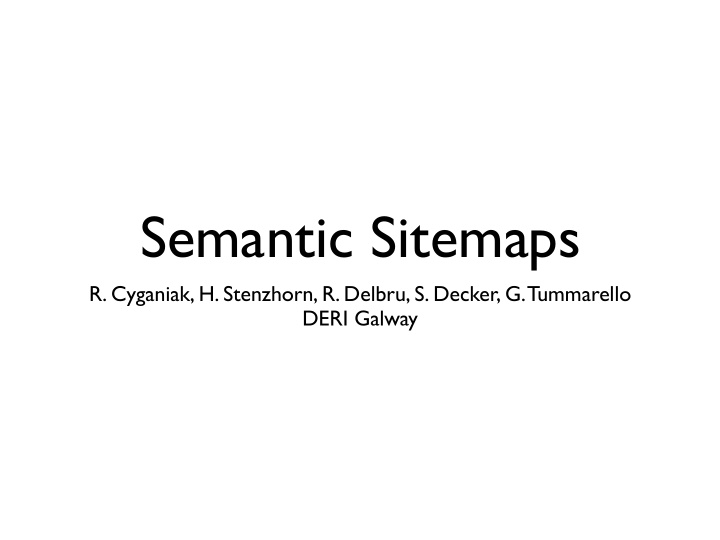



Semantic Sitemaps R. Cyganiak, H. Stenzhorn, R. Delbru, S. Decker, G. Tummarello DERI Galway
A new Web (of Data) • Old: documents for Web browsers • New: structured data for mashups and application integration • Key technology: RDF
Observation: Costs are shifting • Access to RDF data was hard (DMOZ, MusicBrainz) • Today: SPARQL protocol, Linked Data, Tabulator, … • Today: More data (FOAF, Linking Open Data) • Problem is no longer access but discovery
Towards a map of the new Web • Swoogle • SWSE • Falcon-S • Watson • Sindice
3 challenges
1. Different access methods Linked RDF SPARQL Data dumps endpoints
• GET to http://dbpedia.org/resource/Tenerife • Dumps from http://downloads.dbpedia.org/ • SPARQL to http://dbpedia.org/sparql • Same data everywhere
2. Crawl performance • Toy servers, aggressive crawlers • 1 request per second = 2.6M per month • Geonames has 6M+ entities • If a dump is available, how would a crawler know?
3. Provenance • Is built-in feature of the Web (DNS) • URI ownership, authoritative information • Delegation of URI space not visisble
Proposed solution
Semantic Sitemaps • Publishers tell us where they have RDF data • Based on Google’s Sitemap protocol • Put a simple XML file on your server
Google’s Sitemap protocol http://example.com/sitemap.xml <urlset> <url> <loc>http://www.example.com/</loc> <lastmod>2008-01-01</lastmod> <changefreq>monthly</changefreq> </url> ... more ... </urlset>
Semantic Sitemaps <urlset> ... <sc:dataset> </sc:dataset> </urlset>
Semantic Sitemaps <urlset> ... <sc:dataset> <sc:linkedDataPrefix> http://dbpedia.org/resource/ </sc:linkedDataPrefix> </sc:dataset> </urlset>
Semantic Sitemaps <urlset> ... <sc:dataset> <sc:linkedDataPrefix> http://dbpedia.org/resource/ </sc:linkedDataPrefix> <sc:dataDumpLocation> http://downloads.dbpedia.org/dump.nt.gz </sc:dataDumpLocation> </sc:dataset> </urlset>
Semantic Sitemaps <urlset> ... <sc:dataset> <sc:linkedDataPrefix> http://dbpedia.org/resource/ </sc:linkedDataPrefix> <sc:dataDumpLocation> http://downloads.dbpedia.org/dump.nt.gz </sc:dataDumpLocation> <sc:sparqlEndpointLocation> http://dbpedia.org/sparql </sc:sparqlEndpointLocation> </sc:dataset> </urlset>
Semantic Sitemaps <urlset> ... <sc:dataset> <sc:linkedDataPrefix> http://dbpedia.org/resource/ </sc:linkedDataPrefix> <sc:dataDumpLocation> http://downloads.dbpedia.org/dump.nt.gz </sc:dataDumpLocation> <sc:sparqlEndpointLocation> http://dbpedia.org/sparql </sc:sparqlEndpointLocation> <changefreq>monthly</changefreq> </sc:dataset> </urlset>
More elements • sc:datasetLabel: Name for the dataset • sc:datasetURI: Hook for additional metadata • sc:authority: Hook for identifying the publisher • sc:sampleURI: Some representative URIs from the DS • …
Why XML? • Conservative webmasters • Simple
Sitemap discovery domain http:// domain /robots.txt User-agent: * Disallow: Sitemap: sitemap.xml http:// domain /sitemap.xml <urlset> ... </urlset>
1. Different access methods • Clients can choose between • sc:linkedDataPrefix • sc:dataDumpLocation • sc:sparqlEndpointLocation
2. Crawl performance • Crawlers can discover and use RDF dump • Experiment: Downloading and slicing Uniprot takes ~25h and can be parallelized • Crawling Uniprot would take ~5 months • Bottleneck moves from retrieval to indexing
3. Provenance • Delegating and joining URI spaces with sc:subSitemap and sc:parentSitemap • Describing the publisher with sc:authority • URI space can be authoritatively served from a dump or SPARQL endpoint
Community and adoption • Most large LOD datasets have a sitemap • Supported by Sindice and SWSE • Publishers are receptive • They want a validator • public-lod@w3.org mailing list
Next steps • Updated draft • Sitemap creator + validator • Work on content descriptions (VOID)
Semantic Sitemaps … • … are a proposal for better RDF discovery • … allow publishers to announce their data • … allow consumers to efficiently find it • … have hooks for describing content and authority
http://sw.deri.org/2007/07/sitemapextension/ richard@cyganiak.de
Recommend
More recommend